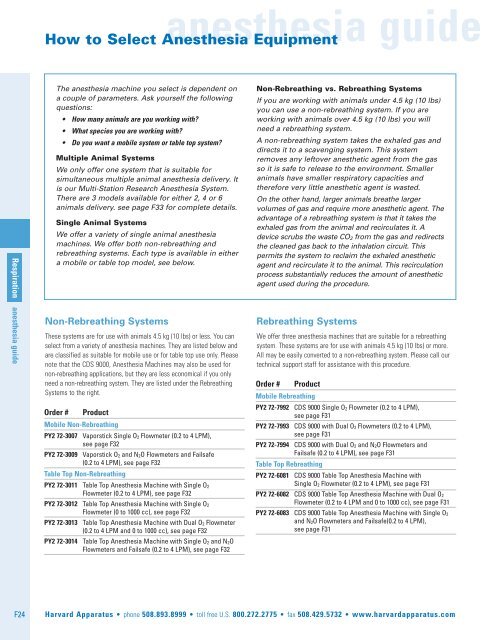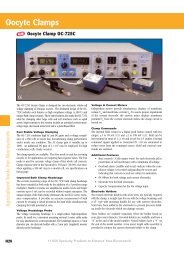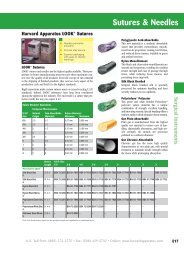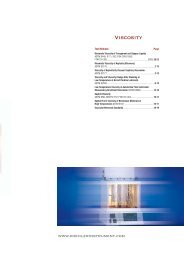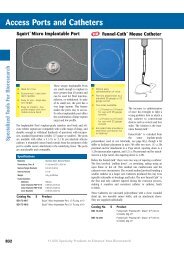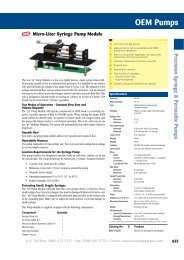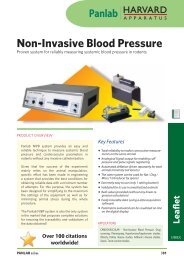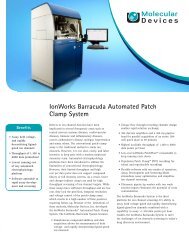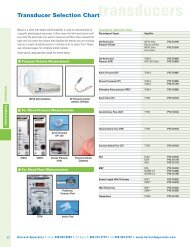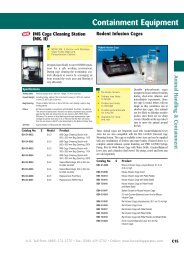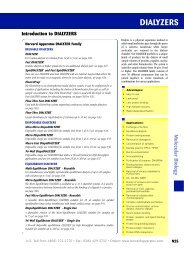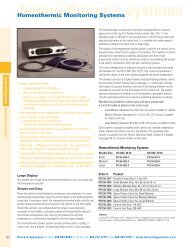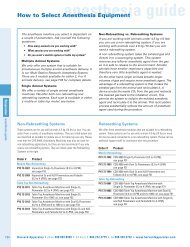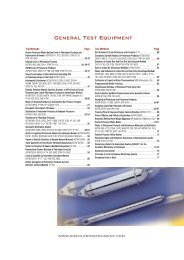anesthesia guide
anesthesia guide
anesthesia guide
Create successful ePaper yourself
Turn your PDF publications into a flip-book with our unique Google optimized e-Paper software.
<strong>anesthesia</strong> <strong>guide</strong>How to Select Anesthesia EquipmentRespirationThe <strong>anesthesia</strong> machine you select is dependent ona couple of parameters. Ask yourself the followingquestions:• How many animals are you working with?• What species you are working with?• Do you want a mobile system or table top system?Multiple Animal SystemsWe only offer one system that is suitable forsimultaneous multiple animal <strong>anesthesia</strong> delivery. Itis our Multi-Station Research Anesthesia System.There are 3 models available for either 2, 4 or 6animals delivery. see page F33 for complete details.Single Animal SystemsWe offer a variety of single animal <strong>anesthesia</strong>machines. We offer both non-rebreathing andrebreathing systems. Each type is available in eithera mobile or table top model, see below.Non-Rebreathing vs. Rebreathing SystemsIf you are working with animals under 4.5 kg (10 lbs)you can use a non-rebreathing system. If you areworking with animals over 4.5 kg (10 lbs) you willneed a rebreathing system.A non-rebreathing system takes the exhaled gas anddirects it to a scavenging system. This systemremoves any leftover anesthetic agent from the gasso it is safe to release to the environment. Smalleranimals have smaller respiratory capacities andtherefore very little anesthetic agent is wasted.On the other hand, larger animals breathe largervolumes of gas and require more anesthetic agent. Theadvantage of a rebreathing system is that it takes theexhaled gas from the animal and recirculates it. Adevice scrubs the waste CO 2 from the gas and redirectsthe cleaned gas back to the inhalation circuit. Thispermits the system to reclaim the exhaled anestheticagent and recirculate it to the animal. This recirculationprocess substantially reduces the amount of anestheticagent used during the procedure.<strong>anesthesia</strong> <strong>guide</strong>Non-Rebreathing SystemsThese systems are for use with animals 4.5 kg (10 lbs) or less. You canselect from a variety of <strong>anesthesia</strong> machines. They are listed below andare classified as suitable for mobile use or for table top use only. Pleasenote that the CDS 9000, Anesthesia Machines may also be used fornon-rebreathing applications, but they are less economical if you onlyneed a non-rebreathing system. They are listed under the RebreathingSystems to the right.Order # ProductMobile Non-RebreathingPY2 72-3007 Vaporstick Single O 2 Flowmeter (0.2 to 4 LPM),see page F32PY2 72-3009 Vaporstick O 2 and N 2O Flowmeters and Failsafe(0.2 to 4 LPM), see page F32Table Top Non-RebreathingPY2 72-3011 Table Top Anesthesia Machine with Single O 2Flowmeter (0.2 to 4 LPM), see page F32PY2 72-3012 Table Top Anesthesia Machine with Single O 2Flowmeter (0 to 1000 cc), see page F32PY2 72-3013 Table Top Anesthesia Machine with Dual O 2 Flowmeter(0.2 to 4 LPM and 0 to 1000 cc), see page F32PY2 72-3014 Table Top Anesthesia Machine with Single O 2 and N 2OFlowmeters and Failsafe (0.2 to 4 LPM), see page F32Rebreathing SystemsWe offer three <strong>anesthesia</strong> machines that are suitable for a rebreathingsystem. These systems are for use with animals 4.5 kg (10 lbs) or more.All may be easily converted to a non-rebreathing system. Please call ourtechnical support staff for assistance with this procedure.Order # ProductMobile RebreathingPY2 72-7992 CDS 9000 Single O 2 Flowmeter (0.2 to 4 LPM),see page F31PY2 72-7993 CDS 9000 with Dual O 2 Flowmeters (0.2 to 4 LPM),see page F31PY2 72-7994 CDS 9000 with Dual O 2 and N 2O Flowmeters andFailsafe (0.2 to 4 LPM), see page F31Table Top RebreathingPY2 72-6081 CDS 9000 Table Top Anesthesia Machine withSingle O 2 Flowmeter (0.2 to 4 LPM), see page F31PY2 72-6082 CDS 9000 Table Top Anesthesia Machine with Dual O 2Flowmeter (0.2 to 4 LPM and 0 to 1000 cc), see page F31PY2 72-6083 CDS 9000 Table Top Anesthesia Machine with Single O 2and N 2O Flowmeters and Failsafe(0.2 to 4 LPM),see page F31F24Harvard Apparatus • phone 508.893.8999 • toll free U.S. 800.272.2775 • fax 508.429.5732 • www.harvardapparatus.com
<strong>anesthesia</strong> <strong>guide</strong>How to Select Anesthesia EquipmentEvacuation System Selection GuideEvacuation Systems are necessary when waste gas from the animal still contains anesthetic agents. It mustbe removed from the exhausted gas before it can be released into the environment. What kind of evacuationsystems are available for waste <strong>anesthesia</strong> gas? Harvard Apparatus has several options to choose from. Selectthe system that best suits your application.F/Air Evacuation Pure-Guard Lab Animal AES Active GasSystem Fluovac System Monitor System Evacuation System Evacuation SystemCanister Style Canister Style Canister Style Charcoal Cartridge Passive Flow SystemEvacuation System Evacuation System Evacuation SystemEach canister can be used for For use with a single For use with a single Can be used with up to For use with a single1 <strong>anesthesia</strong> machine, multiple <strong>anesthesia</strong> machine <strong>anesthesia</strong> machine 6 <strong>anesthesia</strong> machines <strong>anesthesia</strong> machinecanisters for multiple machinesEach canister can remove Each canister can remove 70 grams 1 lb No limitation on amount50 grams of pure 200 grams of halogenated of anesthetic agenthalogenated anesthetic gases anesthetic gasesPassively scavenges waste Actively scavenges waste Passively scavenges waste Actively or passively Active flow collects gasscavenges wastefrom <strong>anesthesia</strong> machineDoes not require Does not require Does not require Maybe be vented directly Must be vented to aventing to a hood venting to a hood venting to a hood to room when using charcoal fume hood or outsidecartridge or to a hood if desired. charcoal filtrationEasy disposal in Easy disposal in Easy disposal in Charcoal may be disposed Two standard inlet portregular trash regular trash regular trash of in regular trash and on exhaust port hookup to existing equipmentCanister is System Requires Fluosorber Canisters Requires Enviro-Pure Canisters Requires charcoal refill cartridges No cartridges requiredsee page F34 see page F46 see page F35 see page F33 see page F34for complete details for complete details for complete details for complete details for complete details<strong>anesthesia</strong> <strong>guide</strong> RespirationHarvard Apparatus • phone 508.893.8999 • toll free U.S. 800.272.2775 • fax 508.429.5732 • www.harvardapparatus.comF25
<strong>anesthesia</strong> <strong>guide</strong>Evacuation System Selection Guide (continued)Evacuation System Selection GuideHarvard Apparatus offers five basic evacuation/scavenging systems that work with our <strong>anesthesia</strong> setups. A brief description of these systemsand their components are listed below. Three of the systems have multiple configurations based on your <strong>anesthesia</strong> setup. The basiccomponents are the same, just connections and adapters change with each configuration.F/Air EvacuationThis evacuation system is a simpleand economical way of removinganesthetic gases. The activecharcoal in the canister removesthe waste gas. The used canistercan be tossed in the trash fordisposal. See page F34 forcomplete details.Fluovac SystemThe Fluovac Systems activelyscavenges anesthetic waste anddoes not require venting to ahood. It uses the FluosorberCanisters, which when full, can bedisposed of in the regular trash.See page F46 for complete details.Respiration<strong>anesthesia</strong> <strong>guide</strong>Configuration Components Order #1-A F/Air Canisters, case of 8 PY2 72-1294Tubing Connector PY2 60-5251Rodent Circuit Set PY2 72-3026Respiratory Adaptor PY2 72-28891-B F/Air Canisters, case of 8 PY2 72-1294Tubing Connector PY2 60-5251Active Gas EvacuationThis evacuation system removesthe waste gas from the <strong>anesthesia</strong>circuit and vents it to a wastesystem, ventilation hood or theoutdoors. See page F34 forcomplete details.Configuration Components Order #3-A Fluovac System 110V (230V) PY2 34-0388/PY2 34-0387Fluosorber Canisters PY2 34-0415Pure-Guard MonitorSystemThe Pure-Guard System is similarto the F-Air Canister Systems, butit removes all the guess work. Thesystem monitors the status of thecharcoal canister and alarms youwhen it requires changing. Seepage F35 for complete details.Configuration Components Order #2-A AES Active Gas Evacuation PY2 72-3065Tubing PY2 72-3093Male Adaptor, 19 mm PY2 72-3085Rodent Circuit Set PY2 72-3026Respiratory Adaptor PY2 72-28892-B AES Active Gas Evacuation PY2 72-3065Tubing PY2 72-3093Male Adaptor, 19 mm PY2 72-30852-C AES Active Gas Evacuation PY2 72-3065Tubing PY2 72-3093Configuration Components Order #4-A Pure-Guard Monitor System PY2 72-8119Rodent Circuit Set PY2 72-3026Respiratory Adaptor PY2 72-28894-B Pure-Guard Monitor System PY2 72-8119Lab Animal EvacuationSystemThis evacuation system is suitablefor evacuating waste anestheticgases from 1 to 6 stations. It wasdesigned for those facilities to donot have built-in evacuation systemsor fume hoods. See page F33 forcomplete details.Configuration Components Order #5-A Lab Animal Evacuation System PY2 72-3066Charcoal Refill PY2 72-3067F26Harvard Apparatus • phone 508.893.8999 • toll free U.S. 800.272.2775 • fax 508.429.5732 • www.harvardapparatus.com
<strong>anesthesia</strong> <strong>guide</strong>How to Select Anesthesia Equipment (continued)Classic T3VaporizersPY2 60-5244 Manifoldwith 8 PortsVaporizer Selection GuideVaporizers are designed to work with a specific anesthetic agent. Selectthe vaporizer based on the agent you will be using in your laboratory.We offer vaporizers for Isoflurane and Sevoflurane, see page F36 forcomplete product offering. Please note that vaporizer endcaps are includedwith the <strong>anesthesia</strong> machine NOT the vaporizer. Therefore, if you areordering a vaporizer ONLY you will need to order endcaps separately(1 x PY2 72-3043 and 1 x PY2 72-3044).SpecificationsInlet FlowCompensationTemperature RangeCompensationCalibrationAccuracyDuration of UseLiquid CapacityDimensions (H x W x D):Funnel FillKey FillWeight:Funnel FillKey FillT350 mls to 10 liters/min with minimal changein output concentration59ºF to 95ºF (15ºC to 35ºC)69.8ºF (21ºC)± 15% (within above flow and temperature range)approximately 1.0 ml of liquid anesthetic is requiredto provide 200 ml of vapor125 ml liquid capacity, with 35 mls absorbed by wick7.25 in x 5 in x 5.5 in7.25 in x 5 in x 6 in16 lbs (7.27 kg)16 lbs (7.27 kg)Why Use an Anesthetic Manifold?Manifolds allow the use of both an anesthetizing box and a mask. Itpermits the research to direct the flow of gas to where they need it. Theanesthetizing box can be used to initially anesthetize the animal and thenthe mask can maintain the anesthetized state during procedures. One sideof the manifold directs the fresh gas to the animal, while the other directsthe waste gas collection.Harvard Apparatus does not suggest using manifolds to anesthetizemultiple animals simultaneously. PLEASE NOTE, with a manifold, theamount of agent flowing into each port cannot be controlled – forindividual control to multiple animals, see the Multi-Station ResearchSystem on page F33 of this catalog.Order # ProductPY2 60-5242 4 Port Manifold – connects to 2 Anesthetic devicesPY2 60-5243 6 Port Manifold – connects to 3 Anesthetic devicesPY2 60-5244 8 Port Manifold – connects to 4 Anesthetic devices<strong>anesthesia</strong> <strong>guide</strong> RespirationOrder #PY2 72-8132PY2 72-7995PY2 72-7997PY2 72-7996ProductT3 Isoflurane Funnel-Fill Vaporizer*T3 Sevoflurane Funnel-Fill Vaporizer*T3 Isoflurane Key-Fill Vaporizer*T3 Sevoflurane Key-Fill Vaporizer*Harvard Apparatus • phone 508.893.8999 • toll free U.S. 800.272.2775 • fax 508.429.5732 • www.harvardapparatus.comF27
<strong>anesthesia</strong> <strong>guide</strong>Anesthesia System Selection GuideAnesthesia System Selection GuideHarvard Apparatus offers a wide range of Anesthesia configurations to meet most <strong>anesthesia</strong> needs.Summarized below are some of the systems available. Select from freestanding and table top <strong>anesthesia</strong>machines. Each type is available with a variety of methods for connecting the <strong>anesthesia</strong> circuit to the animal.With each type of system there is also a variety of evacuation systems available. These evacuations systemsare described in summary format with all of the required components on pages F25 and F26.Respiration<strong>anesthesia</strong> <strong>guide</strong>Vaporstick System with Manifold –Connecting to a Box and a MaskComponents Order #Vaporstick AnesthesiaPY2 72-3007 for O 2 OnlyMachinePY2 72-3009 for O 2 and N 2OVaporizerDepends on desired agentManifold PY2 60-5242Anesthetizing BoxPY2 50-0108 Smallor PY2 50-0116 LargeSupply Line Adaptor PY2 72-60003/16” ID Tubing PY2 72-1024Options for Evacuation: (see pages F25 and F26)SystemConfigurationF/Air EvacuationAES Active Gas EvacuationFluovac SystemPure-Guard Monitor System1A2A3A4ATable Top System with Manifold –Connecting to a Box and a MaskComponents Order #Basic Table Top PY2 72-3011, PY2 72-3012,Anesthesia Machineor PY2 72-3013 for O 2 OnlyPY2 72-3014 for O 2/N 2OVaporizerDepends on desired agentManifold PY2 60-5242Anesthetizing BoxPY2 50-0108 Small orPY2 50-0116 Large3/16” ID Tubing PY2 72-1024Options for Evacuation: (see pages F25 and F26)SystemConfigurationF/Air EvacuationAES Active Gas EvacuationFluovac SystemPure-Guard Monitor System1A2A3A4AVaporstick System with Mask OnlyComponents Order #Vaporstick AnesthesiaMachineVaporizerSupply Line Adaptor PY2 72-6000PY2 72-3007 for O 2 OnlyPY2 72-3009 for O 2 and N 2ODepends on desired agent3/16” ID Tubing PY2 72-1024Options for Evacuation: (see pages F25 and F26)SystemF/Air EvacuationAES Active Gas EvacuationFluovac SystemPure-Guard Monitor SystemConfiguration1A2A3A4ATable Top System with Mask OnlyComponents Order #Basic Table Top PY2 72-3011, PY2 72-3012,Anesthesia Machineor PY2 72-3013 for O 2 OnlyPY2 72-3014 for O 2/N 2OVaporizerDepends on desired agent3/16” ID Tubing PY2 72-1024Options for Evacuation: (see pages F25 and F26)SystemConfigurationF/Air EvacuationAES Active Gas EvacuationFluovac SystemPure-Guard Monitor System1A2A3A4AF28Harvard Apparatus • phone 508.893.8999 • toll free U.S. 800.272.2775 • fax 508.429.5732 • www.harvardapparatus.com
<strong>anesthesia</strong> <strong>guide</strong>Anesthesia System Selection Guide (continued)Vaporstick System with InductionChamber OnlyComponents Order #Vaporstick AnesthesiaMachineVaporizerPY2 72-3007 for O 2 OnlyPY2 72-3009 for O 2 and N 2ODepends on desired agentSupply Line Adaptor PY2 72-6000Anesthetizing BoxPY2 50-0108 Small orPY2 50-0116 Large3/16” ID Tubing PY2 72-1024Options for Evacuation: (see pages F25 and F26)SystemConfigurationF/Air EvacuationAES Active Gas EvacuationFluovac SystemPure-Guard Monitor System1BB3A4BTable Top System with InductionChamber OnlyComponents Order #Basic Table Top PY2 72-3011, PY2 72-3012,Anesthesia Machineor PY2 72-3013 for O 2 OnlyPY2 72-3014 for O 2/N 2OVaporizerDepends on desired agentSupply Line Adaptor PY2 72-6000Anesthetizing BoxPY2 50-0108 Small orPY2 50-0116 Large3/16” ID Tubing PY2 72-1024Options for Evacuation: (see pages F25 and F26)SystemConfigurationF/Air EvacuationAES Active Gas EvacuationFluovac SystemPure-Guard Monitor System1B2B3A4BVaporstick System with VentilatorComponents Order #Vaporstick AnesthesiaMachineVaporizerVentilatorPY2 72-3007 for O 2 OnlyPY2 72-3009 for O 2 and N 2ODepends on desired agentPY2 55-0000 Small AnimalModel 683 VentilatorPY2 55-7058 Inspira AdvancedSafety Ventilator – VolumeControlledPY2 55-7059 Inspira AdvancedSafety Ventilator – PressureControlledPY2 73-0043/PY2 73-0044Mini Vent Mouse VentilatorIntubation/Tracheal Cannula Dependent on the weight rangeof animal being ventilated*Supply Line Adaptor PY2 72-6000If using 683 or Inspira Ventilators – you will also need:Connection Kit PY2 73-30763/16” ID tubing PY2 72-1024If using the 687, MicroVent, MiniVent or MidiVent Ventilators – you willalso need:Connection Kit PY2 73-3077Options for Evacuation: (see pages F25 and F26)SystemConfigurationF/Air Evacuation1BAES Active Gas Evacuation 2CFluovac System3APure-Guard Monitor System 4B* Note: Additional tubing may be necessary to connect to ventilator depending on size cannulaselected. Please refer to Cannula Selection Chart on page F21.<strong>anesthesia</strong> <strong>guide</strong> RespirationHarvard Apparatus • phone 508.893.8999 • toll free U.S. 800.272.2775 • fax 508.429.5732 • www.harvardapparatus.comF29
<strong>anesthesia</strong> <strong>guide</strong>Anesthesia System Selection Guide (continued)Respiration<strong>anesthesia</strong> <strong>guide</strong>Table Top System with VentilatorComponents Order #Basic Table Top PY2 72-3011, PY2 72-3012,Anesthesia Machineor PY2 72-3013 for O 2 OnlyPY2 72-3014 for O 2/N 2OVaporizerDepends on desired agentVentilatorPY2 55-0000 Small AnimalModel 683 VentilatorIntubation/Tracheal CannulaPY2 55-7058 Inspira AdvancedSafety Ventilator – VolumeControlledPY2 55-7059 Inspira AdvancedSafety Ventilator – PressureControlledPY2 73-0043/PY2 73-0044Mini Vent Mouse VentilatorDependent on the weight rangeof animal being ventilated*If using 683 or Inspira Ventilators – you will also needConnection Kit PY2 73-30763/16” ID tubing PY2 72-1024If using the 687, MicroVent, MiniVent or MidiVent Ventilators – you willalso needConnection Kit PY2 73-3077Options for Evacuation: (see pages F25 and F26)SystemConfigurationF/Air Evacuation1BAES Active Gas Evacuation 2CFluovac System3APure-Guard Monitor System 4B* Note: Additional tubing may be necessary to connect to ventilator depending on size cannulaselected. Please refer to Cannula Selection Chart on page F21.Multi-Station SystemsComponents Order #Multi-StationAnesthesia MachineVaporizerPY2 72-3023 Lab Animal2-Station SystemPY2 72-3024 Lab Animal4-Station SystemPY2 72-3025 Lab Animal6-Station SystemDepends on desired agentOptions for Evacuation: (see pages F25 and F26)SystemConfigurationF/Air Evacuation1BLab Animal Evacuation5AMulti-Station Systems include Rodent Circuit Sets (circuit, mask, and uncut diaphragm) for allstations so they do not need to be ordered separately.“Thanks so much for the quote and all your technicaladvice. You folks at Harvard are so helpful, makingmy life much easier! It’s much appreciated.”F30Harvard Apparatus • phone 508.893.8999 • toll free U.S. 800.272.2775 • fax 508.429.5732 • www.harvardapparatus.com


